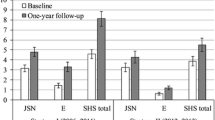Abstract
The objective of the study was to evaluate the effect of initial disease-modifying antirheumatic drug (DMARD) combination therapy with steroids (ICTS) and DMARD monotherapy (IMT) on the clinical and radiologic evolution of patients with early rheumatoid arthritis (RA) over a 2-year treatment period, applying tight control (TC) in daily practice. Seventy-four DMARD-naive early RA patients received ICTS or IMT in a TC setting. Baseline and year 1 and year 2 X-rays of hands and feet were scored according to Sharp/van der Heijde. Rapid radiographic progression (RRP) was defined as total Sharp score (TSS) of >5 units/year. At year 1, both treatment groups achieved 50 % remission. At year 2, 37 % of IMT and 60 % of ICTS patients were in remission, despite ICTS patients having initially a more severe RA profile. RRP was found in 4/74 patients at year 1: 3 IMT and 1 ICTS patients. Remarkably, three of these four patients had no radiographic progression in the second year. Five other patients had RRP in the second year: four IMT and one ICTS patients. In a TC setting, ICTS and IMT can prevent radiographic progression in the majority of patients in the daily practice of a Belgian academic hospital over 2 years. ICTS seems to be more effective than IMT in achieving higher remission rates and less radiographic progression.

Similar content being viewed by others
References
Boers M, Verhoeven AC, Markusse HM, van de Laar MA, Westhovens R, van Denderen JC et al (1997) Randomised comparison of combined step-down prednisolone, methotrexate and sulphasalazine with sulphasalazine alone in early rheumatoid arthritis. Lancet 350(9074):309–318
Calguneri M, Pay S, Caliskaner Z, Apras S, Kiraz S, Ertenli I et al (1999) Combination therapy versus monotherapy for the treatment of patients with rheumatoid arthritis. Clin Exp Rheumatol 17(6):699–704
Mottonen T, Hannonen P, Leirisalo-Repo M, Nissila M, Kautiainen H, Korpela M et al (1999) Comparison of combination therapy with single-drug therapy in early rheumatoid arthritis: a randomised trial. FIN-RACo trial group. Lancet 353(9164):1568–1573
Goekoop-Ruiterman YP, de Vries-Bouwstra JK, Allaart CF, van Zeben D, Kerstens PJ, Hazes JM et al (2007) Comparison of treatment strategies in early rheumatoid arthritis: a randomized trial. Ann Intern Med 146(6):406–415
Verschueren P, Esselens G, Westhovens R (2008) Daily practice effectiveness of a step-down treatment in comparison with a tight step-up for early rheumatoid arthritis. Rheumatology (Oxford) 47(1):59–64
Durnez A, Vanderschueren G, Lateur L, Westhovens R, Verschueren P (2011) Effectiveness of initial treatment allocation based on expert opinion for prevention of rapid radiographic progression in daily practice of an early RA cohort. Ann Rheum Dis 70(4):634–637
Verschueren P, Esselens G, Westhovens R (2009) Predictors of remission, normalized physical function, and changes in the working situation during follow-up of patients with early rheumatoid arthritis: an observational study. Scand J Rheumatol 38(3):166–172
Boers M, Verhoeven AC, van der Linden S (1997) Combination therapy in early rheumatoid arthritis: the COBRA study. Ned Tijdschr Geneeskd 141(50):2428–2432
van der Heijde D (1999) How to read radiographs according to the Sharp/van der Heijde method. J Rheumatol 26(3):743–745
Benhamou M, Rincheval N, Roy C, Foltz V, Rozenberg S, Sibilia J et al (2009) The gap between practice and guidelines in the choice of first-line disease modifying antirheumatic drug in early rheumatoid arthritis: results from the ESPOIR cohort. J Rheumatol 36(5):934–942
Schipper LG, Vermeer M, Kuper HH, Hoekstra MO, Haagsma CJ, Den Broeder AA et al (2012) A tight control treatment strategy aiming for remission in early rheumatoid arthritis is more effective than usual care treatment in daily clinical practice: a study of two cohorts in the Dutch Rheumatoid Arthritis Monitoring registry. Ann Rheum Dis 71(6):845–850
Kirwan JR, Bijlsma JW, Boers M, Shea BJ (2007) Effects of glucocorticoids on radiological progression in rheumatoid arthritis. Cochrane Database Syst Rev 1, CD006356
Welsing PM, Borm GF, van Riel P (2006) Minimal clinically important difference in radiological progression of joint damage. A definition based on patient perspective. J Rheumatol 33(3):501–507
Bruynesteyn K, van der Heijde D, Boers M, Lassere M, Boonen A, Edmonds J et al (2001) Minimal clinically important difference in radiological progression of joint damage over 1 year in rheumatoid arthritis: preliminary results of a validation study with clinical experts. J Rheumatol 28(4):904–910
Avouac J, Gossec L, Dougados M (2006) Diagnostic and predictive value of anti-cyclic citrullinated protein antibodies in rheumatoid arthritis: a systematic literature review. Ann Rheum Dis 65(7):845–851
Acknowledgments
The authors would like to thank Dr. emeritus Luc Lateur for his contribution in analysing the RX images.
Disclosures
None.
Author information
Authors and Affiliations
Corresponding author
Rights and permissions
About this article
Cite this article
De Cock, D., Vanderschueren, G., Meyfroidt, S. et al. Two-year clinical and radiologic follow-up of early RA patients treated with initial step up monotherapy or initial step down therapy with glucocorticoids, followed by a tight control approach: lessons from a cohort study in daily practice. Clin Rheumatol 33, 125–130 (2014). https://doi.org/10.1007/s10067-013-2398-9
Received:
Revised:
Accepted:
Published:
Issue Date:
DOI: https://doi.org/10.1007/s10067-013-2398-9




